
Salix purpurea, the purple willow, purpleosier willow, or purple osier, is a species of willow native to most of Europe and western Asia north to the British Isles, Poland, and the Baltic States.

Salix viminalis, the basket willow, common osier or osier, is a species of willow native to Europe, Western Asia, and the Himalayas.

Salix polaris, the polar willow, is a species of willow with a circumpolar distribution in the high arctic tundra, extending north to the limits of land, and south of the Arctic in the mountains of Norway, the northern Ural Mountains, the northern Altay Mountains, Kamchatka, and British Columbia, Canada.

Salix pentandra, the bay willow, is a species of willow native to northern Europe and northern Asia. The scientific name refers to the male flowers having five stamens. The English name derives from the resemblance of the leaves to those of the bay laurel; other common names include bay-leaved willow and laurel willow. Its glossy leaves make it more decorative than many other willows, so it is often planted as an ornamental tree.

Salix nigra, the black willow, is a species of willow native to eastern North America, from New Brunswick and southern Ontario west to Minnesota, and south to northern Florida and Texas.

Salix lasiolepis is a species of willow native to western North America.
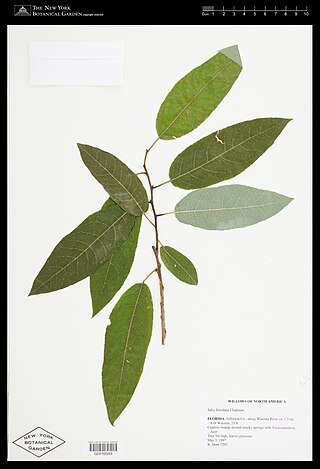
Salix floridana, the Florida willow, is a species of willow in the family Salicaceae. It is native to the southeastern United States in northern Florida and southwestern Georgia.
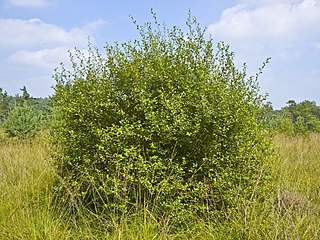
Salix aurita, the eared willow, is a species of willow distributed over much of Europe, and occasionally cultivated. It is a shrub to 2.5 m in height, distinguished from the similar but slightly larger Salix cinerea by its reddish petioles and young twigs. It was named for its persistent kidney-shaped stipules along the shoots.

Salix myrsinifolia, known as the dark-leaved willow or myrsine-leaved willow, is a species of willow native to Europe and Western Siberia. It forms a 2–5 m (6.6–16.4 ft) high shrub. In the north it often becomes a tree up to 8 m (26 ft) tall.
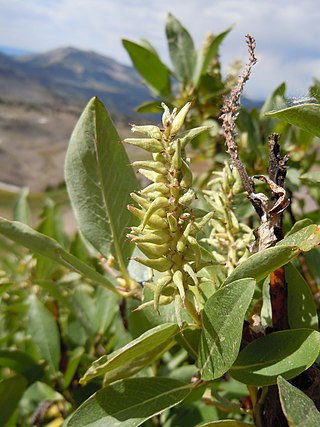
Salix eastwoodiae is a species of willow known by the common names mountain willow, Eastwood's willow, and Sierra willow. It was first described by Bebb in 1879 as Salix californica. This name was later found to be illegitimate, as Lesquereux had given the same name to a fossil willow in 1878.
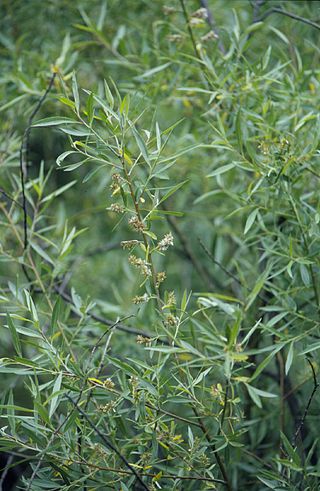
Salix geyeriana is a species of willow known by the common names Geyer's willow, Geyer willow and silver willow. The type specimen was collected by the botanist Karl Andreas Geyer, for whom it was named. Its conspicuous, yellow flowers begin to bloom as early as March, to as late as the end of June.

Salix brachycarpa is a species of flowering plant in the willow family known by the common names barren-ground willow, small-fruit willow and shortfruit willow.
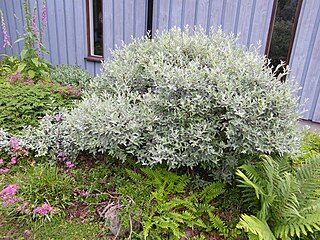
Salix lapponum, the downy willow, is a low, much-branched shrub having a wide distribution in Northern Europe, eastwards to the Altai and western Siberia, and is found as far south as the Pyrenees and Bulgaria. In Scotland, UK, it can be found on rocky mountain slopes and cliffs, generally at altitudes of 200–900 m (660–2,950 ft). It grows to a height of 1.5 m (4.9 ft).

Salix eleagnos the bitter willow, olive willow, hoary willow, rosemary willow, or elaeagnus willow, is a species of flowering plant in the family Salicaceae, native to central and southern Europe and south west Asia. Growing to 3 m (10 ft) tall by 5 m (16 ft) broad, it is an erect bushy deciduous shrub with narrow grey-green leaves up to 20 cm (8 in) long, which turn yellow in autumn (fall). The green catkins, 3–6 cm (1–2 in) long, appear with the leaves in spring, male catkins having yellow anthers.

Salix petrophila, commonly known as alpine willow and Rocky Mountain willow, is a Northwest American mountain shrub in the willow family (Salicaceae).
Sierra willow is a native shrub that grows in Central and Northern California, USA, primarily in the White and Inyo Mountains, the High Sierra Nevada and Sierra Nevada East regions. It is fast growing and moderately long-lived. It grows in an upright form to a height of 10 feet (3.0 m), with active growth during the spring and summer. Flowers are yellow and bloom in the mid-spring. Leaves are medium green and deciduous. It tends to grow in meadows and wet places. Sierra Willow is a common name for several plants and may refer to:

Salix eriocephala, known as heart-leaved willow or Missouri River willow, is a species of willow native to a large portion of the temperate United States and Canada.

Salix humilis, known as prairie willow, is a species of willow native to the United States and Canada, east of the Rockies.
Salix calcicola, known as limestone willow or woolly willow, is a species of willow native to the subarctic and Arctic regions of Canada, including Nunavut Islands, continental Nunavut, northern Quebec, Labrador. Arctic islands: Baffin, King William, Southampton, and Coats.

















